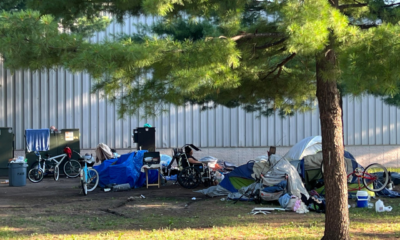National
Do two Wisconsin elections provide test run for presidential race

MADISON, Wis. (AP) — President Donald Trump’s road to re-election a year from now runs through Wisconsin, but both sides will get chances months earlier to measure where their operations, and voters, stand in the hotly contested state.
A special election to fill a rural Wisconsin congressional seat vacated by Republican Sean Duffy will test the enthusiasm of conservatives in a key district for Trump that he won by 20 points on his way to victory in Wisconsin by less than a point. And a statewide Supreme Court election is expected to serve as a dry run for the much larger presidential get-out-the-vote machines Republicans and Democrats have been assembling for months.
“We’re going to test out our tactics, see what works,” said Wisconsin Democratic Party Chairman Ben Wikler.
Both he and Wisconsin Republican Party Executive Director Mark Jefferson said the two spring elections are a huge opportunity for dry runs as well as to gather data about voters that can be used to bolster turnout in the presidential race.
“It allows us to get our grass roots fired up and pointed in a positive direction,” Jefferson said.
It’s particularly valuable to test technology used to reach targeted voters and give your volunteers some experience, said Republican strategist Mark Graul, who ran George Bush’s 2004 Wisconsin campaign.
“You don’t get a second chance in November,” Graul said.
While the parties see the races as a test run, the candidates are making moves that shed light on how the presidential race will affect things.
The leading Republican candidates to replace Duffy are closely aligning themselves with Trump, much like Duffy did in the deeply conservative district. There’s little to be gained for a Republican in that district, which Trump won by 20 points, to distance themselves from the president.
Trump’s chances to take Wisconsin depend on running up big margins in the district, so getting a chance to gather data on voters and test their turnout operations in the special election is a bonus, Jefferson said. Democrats are doing just the same.
“A lot of politics is which side is able to learn more faster,” Wikler said.
Graul said both sides will be particularly focused on seeing how well they can reach non-traditional voters.
There are early signs that liberals are trying to nationalize the Supreme Court race, much like was done in 2018 , by tying conservative incumbent Justice Dan Kelly to Trump. Polls show the president’s approval rating below 50% in Wisconsin and support for impeachment rising.
“My opponent supports Trump,” tweeted Jill Karofsky, a Dane County judge running for Supreme Court this year. She forwarded a picture of Kelly standing in front of a Trump re-election sign at a campaign stop.
Kelly, who was appointed to the Supreme Court by former Republican Gov. Scott Walker, is trying to argue the race is about experience, not politics. He argues on the campaign trail that politics should be “left to the politicians,” while he makes the rounds on conservative talk radio and appears at Republican events.
Karofsky and Marquette University law school professor Ed Fallone, respectively, are sticking largely with Democratic events.
But they are also looking to the 2018 Supreme Court race as a model for how to win. In that race, the liberal candidate and her supporters in many ways framed the contest as a referendum on Trump. Rebecca Dallet won the support, and money, of Democrats along the way, including the endorsement of former Vice President Joe Biden and U.S. Sen. Cory Booker, who are both presidential candidates.
It worked. Dallet won 24 counties that Trump had carried in 2016, giving Democrats a boost of confidence and energy heading into the fall.
Jessica Lovejoy, a Democratic strategist who ran Dallet’s campaign, said the race result will show how energized liberals are heading into the fall. Similarly, the special congressional election in a district Trump won by 20 points could show whether there’s a drop in Republican enthusiasm, said longtime GOP strategist Brandon Scholz.
“If it does slip and it doesn’t have the turnout everyone expects … then you probably have some head scratching that would go on,” Scholz said.
The primary in the race to replace Duffy is Feb. 18 and the general election is May 12, a date Democratic Gov. Tony Evers chose to avoid boosting Republican turnout on the same day as the Supreme Court election. That will be decided on April 7, the same day as Wisconsin’s presidential primary and an election for Milwaukee County executive, which could further drive turnout among Democrats in that liberal county.
Follow Scott Bauer on Twitter at https://twitter.com/sbauerAP







